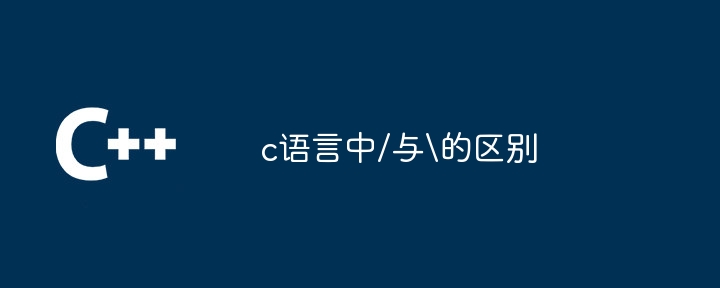The difference between / and \ in c language
C 语言中 / 和 \ 的区别:/:除法运算符,用于两个操作数的除法运算,返回商或余数。\:反斜杠转义字符,用于转义特殊字符、指定文本字符、终止预处理指令,并在 Windows 系统中作为路径分隔符。

C 语言中 / 与 \ 的区别
C 语言中,/ 和 \ 是两个不同的算术运算符,具有不同的功能和用途。
/:除法运算符
- 用于两个操作数之间的除法运算。
- 返回两个操作数的商(浮点除法)或余数(整型除法)。
- 如果操作数为整数,则结果被截断为整数(向下取整)。
\:反斜杠转义字符
- 用于转义特殊字符或执行其他操作。
-
转义字符:将特殊字符(例如
\n换行符)表示为其转义序列。 -
字符串转义:指定字符为文本的一部分,而不是特殊字符(例如
\"双引号)。 - 终止预处理指令:在预处理指令(#define、#include)末尾使用,以防止指令继续到下一行。
-
路径分隔符:在 Windows 系统中用于分隔文件夹路径(例如
c:\windows\system32)。
示例:
int a = 10, b = 3; // 除法运算 float result1 = a / b; // 结果为 3.3333 int result2 = a % b; // 结果为 1 // 反斜杠转义 char message[] = "This is a \\\"test string\\\"."; // 输出:This is a "test string". #define MACRO_VALUE 100 // 终止预处理指令 \#include <stdio.h> // 正确使用反斜杠 // 路径分隔符 char path[] = "c:\\windows\\system32\\cmd.exe"; // Windows 路径
结论:
/ 和 \ 在 C 语言中具有不同的用途和功能。/ 用作除法运算符,而 \ 用作反斜杠转义字符。了解这两种运算符之间的区别对于编写正确的 C 语言程序至关重要。
The above is the detailed content of The difference between / and \ in c language. For more information, please follow other related articles on the PHP Chinese website!

Hot AI Tools

Undresser.AI Undress
AI-powered app for creating realistic nude photos

AI Clothes Remover
Online AI tool for removing clothes from photos.

Undress AI Tool
Undress images for free

Clothoff.io
AI clothes remover

AI Hentai Generator
Generate AI Hentai for free.

Hot Article

Hot Tools

Notepad++7.3.1
Easy-to-use and free code editor

SublimeText3 Chinese version
Chinese version, very easy to use

Zend Studio 13.0.1
Powerful PHP integrated development environment

Dreamweaver CS6
Visual web development tools

SublimeText3 Mac version
God-level code editing software (SublimeText3)

Hot Topics
 Usage of typedef struct in c language
May 09, 2024 am 10:15 AM
Usage of typedef struct in c language
May 09, 2024 am 10:15 AM
typedef struct is used in C language to create structure type aliases to simplify the use of structures. It aliases a new data type to an existing structure by specifying the structure alias. Benefits include enhanced readability, code reuse, and type checking. Note: The structure must be defined before using an alias. The alias must be unique in the program and only valid within the scope in which it is declared.
 The difference between strcpy and strcat in c language
May 08, 2024 pm 01:03 PM
The difference between strcpy and strcat in c language
May 08, 2024 pm 01:03 PM
strcpy copies a string to another string, while strcat appends a string to another string. The main differences include: different purposes, different processing of dst parameters, and different security considerations.
 What does real mean in c language
May 09, 2024 pm 12:06 PM
What does real mean in c language
May 09, 2024 pm 12:06 PM
real is the data type used to represent double-precision floating-point numbers in C language. It occupies 8 bytes, has a precision of about 15 decimal places, and the range is [-1.7976931348623157e+308, 1.7976931348623157e+308].
 What to do if there is an error in scanf in C language
May 09, 2024 am 11:39 AM
What to do if there is an error in scanf in C language
May 09, 2024 am 11:39 AM
In C language, methods for handling scanf function errors include: 1. Check the format string; 2. Check the input; 3. Check the return value; 4. Set the error flag; 5. Use the error handling function; 6. Use custom errors deal with. To prevent errors, use the correct data types, carefully validate input, check return values, and handle potential errors in your program.
 How to implement the power function in C language
May 09, 2024 pm 11:33 PM
How to implement the power function in C language
May 09, 2024 pm 11:33 PM
In C language, there are two ways to implement the exponentiation operation: use the pow() function to calculate the power of the second parameter of the first parameter. Define a custom power function, which can be implemented recursively or iteratively: the recursive method continues to double the power until it is 0. The iterative method uses a loop to multiply the base one by one.
 _complex usage in c language
May 08, 2024 pm 01:27 PM
_complex usage in c language
May 08, 2024 pm 01:27 PM
The complex type is used to represent complex numbers in C language, including real and imaginary parts. Its initialization form is complex_number = 3.14 + 2.71i, the real part can be accessed through creal(complex_number), and the imaginary part can be accessed through cimag(complex_number). This type supports common mathematical operations such as addition, subtraction, multiplication, division, and modulo. In addition, a set of functions for working with complex numbers is provided, such as cpow, csqrt, cexp, and csin.
 How to use restrict in c language
May 08, 2024 pm 01:30 PM
How to use restrict in c language
May 08, 2024 pm 01:30 PM
The restrict keyword is used to inform the compiler that a variable can only be accessed by a pointer, preventing undefined behavior, optimizing code and improving readability: Preventing undefined behavior when multiple pointers point to the same variable. To optimize code, the compiler uses the restrict keyword to optimize variable access. Improves code readability by indicating that variables can only be accessed by a pointer.
 _What does bool mean in c language?
May 08, 2024 pm 01:33 PM
_What does bool mean in c language?
May 08, 2024 pm 01:33 PM
_Bool represents Boolean type in C language. It is a simple data type that contains only two values, true or false. It is used to represent the results of conditions or logical expressions. It usually occupies 1 byte of memory and can only store true or false. false value.






